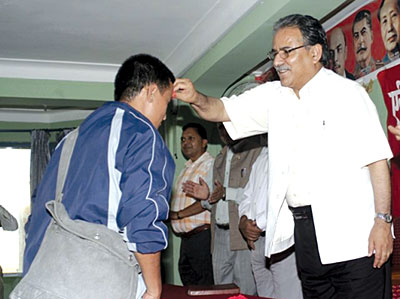 |
The grand festival of Dasain is finally over. What's changed and what's not in the way we celebrate such an event tells us something about the way we ourselves are adapting to life that is more commercialised, westernised, and reflective of the developments of the last few years.
The general trajectory of this season of festivals has long remained the same. Once the monsoon begins to clear, we all start preparing, mentally and materially, for the working holidays to come (for work it is for many of us, whether it's shopping for the family, hosting parties, or making social visits). Judging by the proliferation of malls and Dasain offers in the Kathmandu Valley, shopping is an altogether more fraught affair these days. But clearly there are people lining up to buy motorbikes (get a free camera!), cameras (win a motorbike!), and falling for the usual sales
Dasain is meant to be about meeting, eating, drinking and gambling with family and friends. There are plenty who choose to take advantage of other offers to up and leave the country altogether these days, but for most Nepalis the fundamental joy of catching up with one's extended family is undiminished. Yes, people complain that they have to spend hot days (and a couple of rainy ones this year) trooping across country and city to receive tika from people they may not see for the rest of the year, but I'd like to think they don't really mind. At least once a year, a circle is completed of one's blood relations, and this grounds an individual within the most ancient part of his or her society. And if you can't quite travel to pharen to be with all your loved ones, you can at least, through wire and web, see just how they are celebrating little Dasains, in Boston, in Doha, in Pune.
For those who imagine Dasain has less significance in a more secular and fragmented society, the sight of determined family units pounding the streets with big red tikas on their foreheads is rebuttal enough. Does custom compel those who can ill afford it to spend time and money beyond their means every Dasain? Perhaps. Has Dasain, for this reason, become "a dasha (ill omen) for the mass of the people", as the fun-loving in-charge of the Cultural Division of the UCPN(Maoist), Ninu Chapagain, put it last year? Not likely, if his solution is to "promote local festivals" that presumably also demand expenditure. To his credit, Chapagain himself argued against the hypocrisy of those communists who speak out against Hindu culture, but use its festivals, Tihar in particular, to collect money for their 'parties'. In doing so, he concedes that political ideology too often loses out against the juggernaut of culture. Cue pictures of Chinese visitors to the Nepal Pavilion at this year's Shanghai Expo, making offerings to every statue of Buddha they came across.
In a charming reversal, Dasain manifests itself best in the blessed emptiness of Kathmandu once hundreds upon thousands evacuate the valley for homesteads across Nepal. The exodus is more dramatic with each passing year, and serves to underline the meaning this festival holds for so many of us, regardless of economics, ethnicity, or the times that be changing. The more things change, the more they stay the same.
READ ALSO:
Corruption, Inc., EDITORIAL
Cocking a snook, DAMAKANT JAYSHI
We know what works, BIHARI K SHRESTHA
Looking east, ARTHA BEED
Communists don't celebrate Dasain



